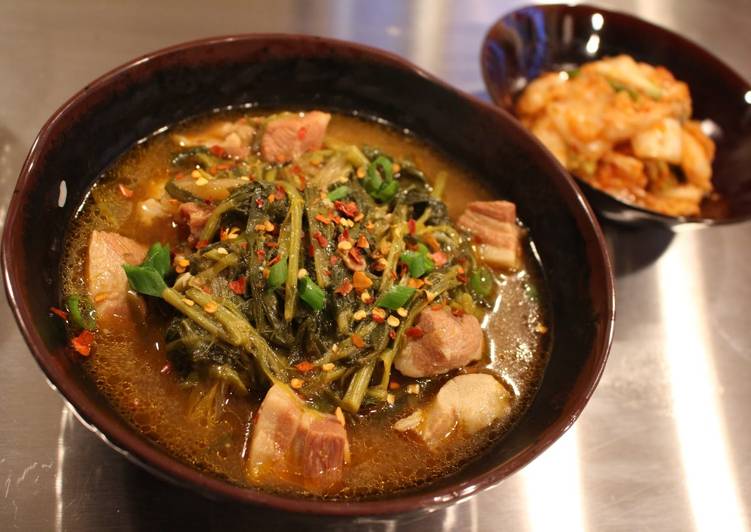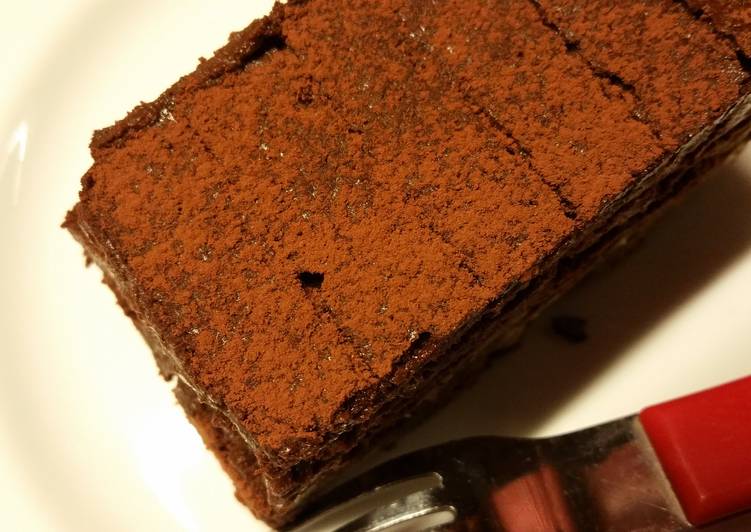
Dwenjang Guk (Spicy, Hearty Korean Style Miso Soup) - Loved ones warmth and closeness is usually obtained in easy methods. One particular of them is cooking and serving food for the household. As a housewife, of course you don't want to miss a meal with each other proper? Cuisine can also be the important to a happy loved ones, many feel homesick mainly because their cooking has been located elsewhere.
So for all those of you who like to cook and like it or not you've to provide food for the family members, not surprisingly you also don't want the exact same dishes, proper? It is possible to cook with new and straightforward variants. Because now you'll be able to simply uncover recipes without possessing to bother. Just like the following Dwenjang Guk (Spicy, Hearty Korean Style Miso Soup) which you'll be able to imitate to become presented to your beloved family members.
Dwenjang Guk (Spicy, Hearty Korean Style Miso Soup) is one of the most favored of current trending foods in the world. It’s enjoyed by millions every day. It is simple, it is quick, it tastes yummy. Dwenjang Guk (Spicy, Hearty Korean Style Miso Soup) is something which I’ve loved my entire life. They’re nice and they look wonderful.
How to make authentic Korean soybean paste soup (Doenjang Guk). Start boiling the dried kelp and dried anchovy stock (Korean style. Doenjang, fermented soybean paste, is a staple Korean condiment and used as a base for stew or soup.
To get started with this particular recipe, we have to first prepare a few components. You can cook dwenjang guk (spicy, hearty korean style miso soup) using 14 ingredients and 7 steps. Here is how you can achieve that.
Composition needed to serve Dwenjang Guk (Spicy, Hearty Korean Style Miso Soup):
- 5 cups unsalted stock (chicken, pork, beef, turkey and veg all work fine)
- 5 cups water
- 1/2 an onion, cut into thirds
- 4 garlic cloves, peeled and crushed
- 1/4 cup dwenjang (or miso if you don't have dwenjang, but dwenjang is usually much more pungent)
- 2 Tablespoons to 1/4 cup gochujang (Korean chili paste), depending on how hot you like things
- 2 teaspoons sugar (to round out the flavors and the salt from the pastes)
- salt and/or fish sauce if needed to adjust the seasoning
- 8 cups leafy green veg, fresh or extruded (it'll look like a lot, but it will reduce quite a bit after cooking)
- 1-2 fresh jalapeños or serranos if you like a little extra heat and chili flavor (optional)
- Optional if you'd like protein (you can do one or the other, or half of each):
- 1 pound pork shoulder or beef stew meat cut into 1-inch cubes (optional, but it helps to have a little protein if you're going to make a meal of it)
- or
- 1 package medium or firm tofu (usually 12 to 14 ounces), drained and cut into 1-inch cubes
Dried anchovies, flour, garlic, green chili pepper, napa cabbage, soybean paste, water. Cabbage Soybean Paste Soup (Baechu Doenjang Guk). This simple soup has meat, vegetables, and a whole lot of flavor from Last on our list of recipes using Doenjang, Gamjatang is a wonderfully hearty and spicy Korean stew made with pork neck bones. Korean Spicy Chicken Breasts (and thighs too) marinated in my sweet n' spicy Gochujang sauce then baked until caramelized. · This cabbage soup (Baechu Dwenjang Guk) made with Korean fermented soybean paste (deonjang/dwenjang) is the ultimate comfort food for Koreans.
Instructions to serve Dwenjang Guk (Spicy, Hearty Korean Style Miso Soup):
- Put the stock, water, onion, garlic, dwenjang, gochujang, sugar, meat and any extruded veg into a large pot (fresh veg goes in later). Bring to a boil, covered, over medium high heat (should take 15 minutes or so).
- Once it's come to a boil, turn the heat down to medium low and simmer, covered, for another 20 minutes before adding any fresh veg and tofu.
- Simmer another 10 minutes or so, then adjust the seasoning for salt. If you've added fresh veg and/or tofu, you will almost certainly need to adjust for the water they will release into the soup.
- Simmer another 15 minutes with the lid askew, adjust seasoning one last time if needed, and that's it!
- If you want to have it with rice, you'll want to put the rice on to cook when you leave the soup to simmer the first time.
- It's always yummier with kimchi. Here's my kimchi recipe (which of course you would have to have made days to weeks in advance): - - https://cookpad.com/us/recipes/1567994-kimchi-easier-than-you-think
- EXTRUDING LIQUID FROM GREENS: Just wash the greens, sprinkle them with salt, and let them sit for a couple of hours, tossing them 2 or 3 times during the process, letting the salt draw the moisture from them. After they've released the excess liquid, just give them a good swish in a big bowl full of clean water, and squeeeeeeeze all that liquid out. You can then freeze the greens for future use, or refrigerate them for 2 to 3 weeks before using.
Korean miso soup or doenjang Jjigae uses the Korean form of miso doenjang (aka Doenjang is similar to Japanese miso but it also contains some uncrushed beans giving The soup was pretty tasty. I think that I will be having the Korean style miso soup for. Simple and savory homemade miso soup with dashi stock, detailed recipe instructions on how to cook different types of miso soup. Spicy potato guk is a very simple and useful daily soup that is especially good on cold days because the spicy broth makes your body warm. Many people usually have potatoes and onions on hand.
So that's going to wrap this up for this special food dwenjang guk (spicy, hearty korean style miso soup) recipe. Thanks so much for your time. I'm confident you can make this at home. There's gonna be interesting food at home recipes coming up. Remember to bookmark this page in your browser, and share it to your loved ones, colleague and friends. Thanks again for reading. Go on get cooking!

